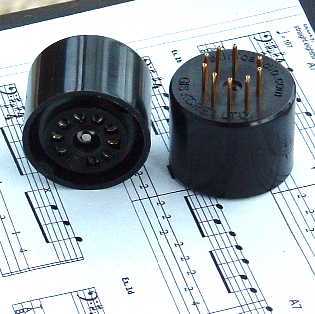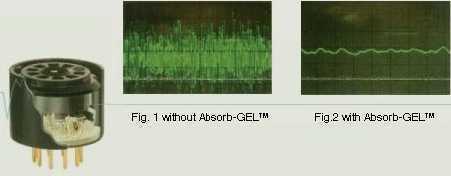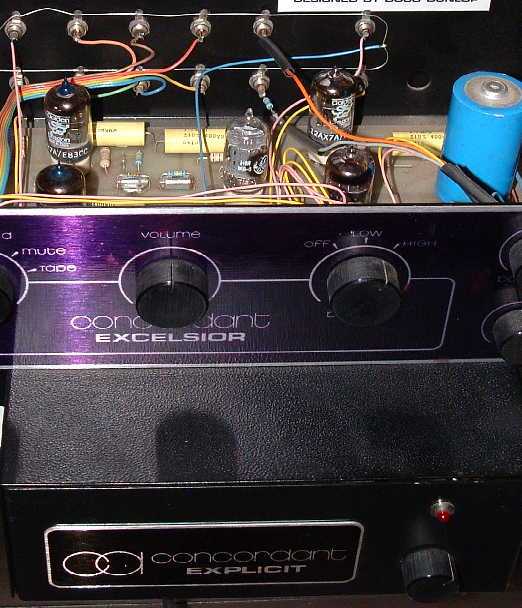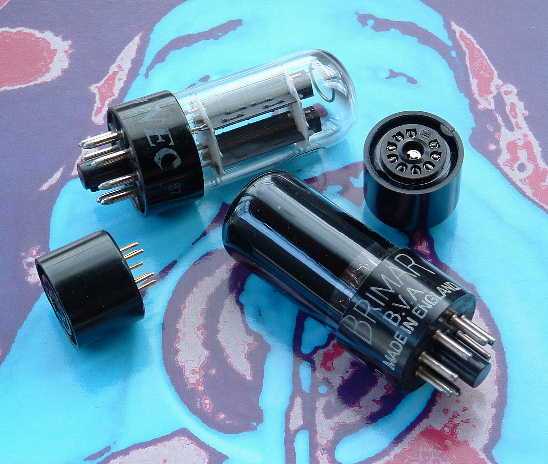Vibration Isolation series Part 9:
Mark's epic saga maintains its momentum
![[flash_gordon_gets_springy]](../jpg/absorb-gel_shanling.jpg)
B9a Absorb-GEL on Shanling CDT100c
![[flash_gordon_gets_springy]](../jpg/absorb-gel_shanling.jpg)
Product: Allnic Absorb-GEL Vacuum Tube Damper
Manufacturer: GIS Allnic Audio - Korea
Distributor: Acoustic-Dimension - Netherlands
Cost: The current price is: 79,95 €
Acoustic Dimension offer a special TNT-audio readers
introductory discount to 60 €
Reviewer: Mark Wheeler - TNT UK
Reviewed: September 2006
"MORE vibration products?
Does this reviewer suffer from Obsessive Compulsive Disorder, or what?"
demand plebs chorus stage-left
"Possibly," replieth the old one, "but they're certainly more interesting and
much more useful than fancy wire..."
"but surely if everyone realises this then the vibes business will get as silly as the wire
business?", counter plebs chorus,
"Fair comment," sayeth the old one, "but vibes-control is still at the same stage
as wire tweakers were in the late 70s, when manufacturers noticed audiophiles were replacing bell-wire with
ring-main cable or co-ax"
Since I acquired the reputation of being willing to test inexpensive gizmos designed to minimise the detrimental effects of vibration on domestic music reproduction, when part 1 of the vibration control series appeared, I have been sent or told of various wondrous new products to transform any audio system, and I was contacted last Autumn, by Rients Steenbeek, and invited to try the Absorb-GEL. The Absorb-GEL is different from anything else I have tried.
The Absorb-GEL claims only to reduce the effects of vibration on one valve (tube) at a time.
The Absorb-GEL inserts beneath just ONE valve and claims to reduce, to the point of insignificance, the detrimental effects of valve microphony on that valve only. You read that right, just one valve per-channel.
The manufacturers reckon they can hear the difference, and have pursuaded Rients Steenbeek of distributors, Acoustic Dimension, that they too can hear the difference, and they hope that purchasers will also be able to hear the difference clearly enough to part with hard-earned cash, or even just their ill-gotten gains. This is a big and courageous claim, but is it just a case of 'the emperor's new clothes'?
Plus my usual question has to be answered, "Is this money better spent than on records or cds or wine or beer"
Test procedure will as usual:
Components are sensitive to structure borne vibrations in the listening room; from the loudspeakers via
the floor, for example. Casework is also sensitive to the airborne vibrations in the room; i.e. the sounds
from your speakers. Steel cases act like plate-microphones in relation to the copper traces of the more
inert pcbs inside.
Valves are all microphonic to some degree, and high-gain small-signal valves (like the ECC83 common in many phono
pre-amps) more than some others. Thus the cases of your audio components will benefit from the vibration
control measures described earlier in this series, and should be read if you are considering any form of
vibration isolation. BUT, if you do use these shortcuts, don't forget to use your back-button to come back real
soon, y'hear?

Transformers vibrate. Some transformers vibrate more than others. The more load is drawn on a transformer, the more it tends to vibrate (other factors being equal). The more complex the current demands, the more complex will be the vibration. For example, a valve amplifier with a single transformer, may have within that transformer (EI-core, C-core, toroid or pixie-dust core) various taps on a primary winding, or a group of primary coils, to permit various international supply voltages via connection permutations. There may several secondaries;
All of of this electro-magnetic transformer action has the potential to excite movement in the transformer. Often transformers are secured by bolts through compliant grommets for this reason. Some vibration will inevitably get through to the circuit components, and to the casework relative to the circuit board and components, possibly inducing distortion, through vibration and electromagnetic effects.
The first answer is to mount the transformer on a remote chassis, separate from the signal handling circuits. Furthermore, the big CLC filters (capacitors & choke) may also vibrate, so they're best located in a box separate from the signal department. If your pre-amplifier, power-amplifier or cd transport is all in one box with its power-supply, and it looks impossible to remove the power-supply to another chassis, what can you do?
In a cd player triple-purpose or quadruple-purpose mains transformers supply various functions, in
addition to those described in the valve pre-amplifier:

Furthermore, the cd player has that clunky mechanical transport generating a selection of vibrations, some continuous, some transient, into the chassis. That's the same chassis where the hyperactive mains transformer is firmly mounted. The same chassis that has smoothing chokes and big psu capacitors mounted. The very same chassis onto which a valve base has been bolted, to support the microphonic valves that are tasked with amplifying the subtlest musical nuances for our listening pleasure. GIS claim a 40dB reduction in measured microphony, but do not indicate what the test conditions were.
With all that stuffed into one box, within one farady screen on one mechanical structure, the Absorb-GEL should have its best-shot in a valve-output single-box cd player. If it makes any difference anywhere, it must be in a valve (tube) equipped cd player. My Chevin audio modified Shanling CDT100c is an obvious candidate. It is musically highly transparent and makes the output valve work much harder than the usual parallel-triode cathode-follower output buffer of the original design. The first problem that arises is that the Shanling has those Flash Gordon spaceship style towers around each valve and they get in the way of the Absorb-GEL. I remove them. The next problem is that the surrounding plastic rim of the Absorb-GEL is a tight fit in the Shanling's upper plate orifice. Actually, this may be a good thing as the squidgy gel-core may serve to provide extra damping on the pcb below as well as providing a lossy support to the valve base above.
I wonder if the effects of the extra connections and fine internal wiring of the Absorb-GEL damper might have a detrimental effect on the sound of the valve. It introduces 18 extra pin-to-sleeve interfaces, and 18 extra solder joints to the circuit. Some of these (grid connections for example) may be at microvolt levels in some applications (especially the first stage in a phono amplifier), while others may be handling a whole amp of dc for the heaters.
To establish whether the extra fine wires and their connections in the Absorb-Gel do have an audible effect, I try installing the dampers after refrigeration to below 2°C, to make the gel less effective. Rients Steenbeek, of Acoustic-Dimension, warned me that the Absorb-Gel needs at least a week to settle in, so trying them for losses will be even more effective at the start of the test procedure. My hypothesis being that the effects of the connections will be most obvious if the effects of the gel are reduced, because the gel itself is temporarily well below room temperature and therefore less-flexible. The damper should be less effective while stiff, and flexibility or fluidity usually increases with temperature in most materials. The cable & junction losses should be similar at any temperature in this sort of 15-20° range. Thus any insertion-loss caused by the connections will be isolated by this test.
I cannot hear any noticeable detrimental effect on insertion of the cold Absorb-GELs. I try repeatedly adding and removing them after only a couple of tracks (to prevent the valve warming the compliant substance), but I only imagine I hear something on some of the times. A casual listener trying this type of A-B check only once may be fooled that there are differences, but repeated tests imply this is only due to suggestibility or variation of insertion pressure or angle. There is not enough insertion loss in this location to produce a consistent effect.
I do not hear losses typical of cables & poor connections, but already hear improvements I would associate with better vibration isolation. So they've got the connections good enough and raised my expectations.
Once warm it is hard to tell what the effect is either, because it takes an hour for the base to become a stable temperature. Removal of the warm Absorb-GEL and replacement of the bare 6Np valve in its socket is much more obvious. A veil returns that I had not really noticed being removed, so gradually had it cleared during warm-up. I repeat the exercise several times to check the effect.
With the Absorb-GEL in place the sound seems less grainy. It's more like the effect of upgrading a power-supply capacitor than most of my previous vibration control experiences. Vocals, especially, seem more natural and distinct from each other when unison singing. The area seemingly filled by the performers seems both wider and deeper, suggesting some improvement in high-frequency phase coherence. A hypothesis might be that the Absorb-GEL reduce the effects of vibration intermodulating with the signal being passed by the valve.
So I listen to the Absorb-GEL working in the worst possible environment for a valve for a couple of months before I wonder where to try it next. How will it work in a less hostile environment, the Concordant Excelsior preamplifier?
The Excelsior has an external power supply, and only dc reaches the pre-amplifier box itself. There are no transformers in the pre-amplifier, and it normally works with the lid-off to minimise electromagnetic distortions. The phonostage's trio of double triodes are where the signal levels are at their lowest, and the first ECC83 (English 12AX7 equivalent) is the big-gain bottle.
Even with the preamplifier mounted without isolation on an unsuitable toughened glass shelf, to exaggerate any vibration problems, there is very little effect. Less effect than there is 3 inexpensive squidgy blobs, like Brightstar Isonodes under the whole pre-amp. The shared milspec GE 5695 double triode that completes the phonostage is more affected than the first pair of ECC83, which is a big surprise as it is supposed to be more vibration resistant than its ECC85 domestic cousin, but even here the Absorb-GEL is still no more effective than correctly supporting the whole pre-amp. The line-stage comprises another pair of ECC83, where the effect of the Absorb-GEL is just audible, but again, not as much as isolators under the whole chassis. The cumulative effect of treating all the pre-amplifier valves could not be tried as I was initially sent only one pair of samples.
I try a better shelf (an ancient Something Solid prototype that Mark Orr developed using the Excelsior), supported by a set of TNT stoneblock variations; then the Excelsior supported by Isonodes, topped-off with the BrightStar IsoRock 5, in place of the pre-amp cover. This would cost the equivalent of 3 sets of Absorb-GELS, enough to treat the whole pre-amplifier and the TV deflector valve in its power supply. The effect of all that external isolation is considerable, way beyond the effect of a pair of Absob-GELs.
Once this total vibration control set-up has been optimised there is little further effect from the Absorb-GELS, even under the most sensitive 3 valves, the GE 5695 & line-stage ECC83's.
I have only one power amplifier in service that uses B9a valves as input & driver, although I try to get a set of Quad II running as they have the input pentodes in the same chassis as the transformer & choke to provide a more rigorous test, but sadly no joy this time. My little 4W SET (loosely based on a Tim de Paravicini design in HiFi-World way back) has E83CC & E88CC input & driver. This amplifier has the output transformers on the same Torlyte case as the valves, but the mains transformer on a separate chassis. The power-supply chassis usually resides on BrightStar Isonodes and the signal-path-case (described in Box Clever, my first article for TNT-audio) on Polychristal Isolators. Both stand on an ERaudio SpaceHarmoniser platform on its steel points. This optimised position has evolved through a long period of trail and error. The effect of the Absorb-GELs is virtually inaudible in this setting, faced with this expensively optimised mechanical vibration-protection system already in place.
The conclusion that seems to emerge from this experiment is that the Absorb-GELs are unlikely to make a significant improvement an already well vibration-isolated system. However, where an individual valve is located in a more hostile environment, prone to mechanical interference, the Absorb-GEL is probably a unique solution.
The Absorb-GEL proves vulnerable to mishandling as for my final check I return them to the Shanling. On attempting to remove one, while still very warm, from its tight fit in the chassis top-plate, an ooze of what-looks-like silicone emerges beside the socket. Typical buyers are unlikely to be inserting, removing, freezing, reinserting, removing, reinserting and removing these bases as often as a reviewer so this is unlikely to be a problem for you. The instructions clearly state that the Absorb-GEL should not be pulled-out while warm, so this reviewer has tested one to destruction by repeatedly performing a forbidden action. I am told mine are the first pair ever to suffer a field failure, so these things are quite strong given the torture I have inflicted before a failure. I immediately get sent a new pair and I expect the helpful folks at Acoustic Dimension would do similar for any purchaser, so surprised were they by any field-failure.
Now that I have heard the effect so strongly in my modified Shanling I would be reluctant to return to using it without the Absorb-GEL dampers in place. They are far more effective than the damping ring formerly applied between the valve-cage and glass. I am so convinced of the effectiveness I decide to try to simulate a single box amplifier.

I place the Concordant Excelsior directly on top of its Explicit power-supply. I place them directly on a clangy toughened-glass shelf. I insert the newly arrived Absorb-GEL pair in the output ECC83 sockets and the other surviving damper under the shared 5695. I leave it to warm up for 30minutes and play. It is not quite as bad as I thought. A couple of LPs later I am still enjoying the music and not really noticing much different when I decide I am familiar enough with the set-up to make a change.
I switch off, remove all 3 Absorb-GEL dampers, while still hot, and reinsert the valves and switch on again. The whole process takes about 10 minutes. I make a cup of tea while the pre-amp returns to operating temperature. I put the first LP I heard earlier back on a favourite track. A layer of graininess is imposed on top of the music. Everything about the music & its presentation seems thinner, a visual analogy would be a grainy overexposed transparency, whereas at its best the Excelsior tends towards Fuji Velvia underexposed by 1/3stop for extra density and vibrancy.
When the audio-circuit valves are struggling to perform while being shaken about by transformer & power-supply vibration, the Absorb-Gel dampers now do have an effect. As I gradually replace the optimum vibration & tuning set-up for this pre-amplifier, the effect diminishes. Once the pre-amp chassis is mounted on Isonodes, on an ERaudio SpaceHarmoniser, on ERaudio steel points, on a separate frame from the power supply the difference is minimal.
As a final twist, I try the Absorb-GEL under the tv deflector valve (tube) mounted next to the transformer in the power supply. I do not expect to hear any effect. When I later remove it, I am surprised to hear more effect than I had done under the pre-amp chassis signal valves. Again the effect is like a layer of gritty dirt, between me and the music, gets cleaned away. This defies logic to me as I do not expect a valve that merely acts as a regulator, in a box, up to 1m away from the signal valves, to have any effect at all. I do know the argument that "an amplifier is nothing more than a modulated power supply", but this effect does seem unlikely. Unlikely, but audible.

Vibration control is surprisingly cheap and effective to begin with. The first steps, like the TNT Stone-Blocks, bring big benefits for very little money. The next steps cost more. The point at which it becomes an economically viable proposition to isolate individual valves (tubes) throughout a complicated high-end audio system becomes a personal choice that is both evidence driven and morally driven (given that the effect the money we spend on audio might have on third-world medicine). That said, this product does justify its existence in some audio contexts.
Where electro-mechanical devices exist alongside valve gain stages, this device becomes very relevant, probably the only option. It is possible to minimise the effect of a mains transformer vibration, or a cd transport, on valve microphony using the Absorb-GEL. The only alternative would be to rebuild the component.
The alternative of isolating a whole circuit board is often impractical in equipment not built by the owner. Even if the board is suspended, it too may generate vibration or its large surface area be excited by external airborne vibration. The only solution is to isolate the individual valve. In the past I have mounted valve-bases on soft compliant grommets to achieve this, but this is not possible on pcb mounted valve bases.
The Absorb-GEL becomes a simple cost effective solution in these instances. Any ready made valve pre-amplifier with the mains transformer in the same case as the audio circuit will benefit. Some power amplifiers may also benefit, after vibration isolation measures have been taken to protect the whole amplifier form vibration interference.
The most immediate obvious must-have role for the Absorb-GEL has to be the valve output-stage cd player. One box might contain a big triple-purpose (or more) mains transformer, a mechanical multiple-motorised transport system and then a delicate microphonic valve amplification device in the analogue output domain. Here the ability to isolate that valve (tube) from all that vibration may well be worth the cost of an extra- connection per pin as well as your 60 €. I wonder how much effect it would have in those all-valve reel-to-reel recorders some audiophile recordists are using. I'd love to hear those master-tapes.
In the context of a multi-stage pre-amplifier with an external power supply the Absorb-GEL is not as cost effective as isolating the whole chassis and the power-supply. More useful in that context is isolation of the pre-amplifier using techniques reviewed earlier in the series.
Driver stages in a power amplifier where mains and output transformers are mounted on the same chassis may be a position where the Absorb-GEL would bring benefits, but until GIS Allnic Audio make an octal version, I will never know.
Given that octal versions of electrically identical valves as their B9a equivalents suffer the reputation of being much more microphonic, I would expect the company to rush that version into production. Please send me samples to test as soon as they're ready as I have high hopes for octal Absorb-GELs.
The GIS Allnic Audio Absorb-GEL is that rare hifi beast: an original idea. It does exactly what is claimed. It is worth using anywhere that a microphonic b9a valve is subject to much vibration that cannot be cured at source. The cost of isolating the output valve of any cd player with the Absorb-GEL is far less than a mid-price cable and far more useful. The Absorb-GEL is worth considering in any b9a valve product with a single shared chassis. Please GIS, start making an octal version soon.
© Copyright 2006 Mark Wheeler - www.tnt-audio.com